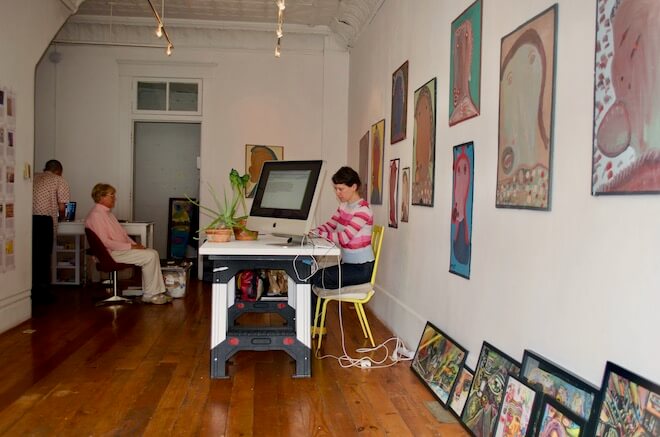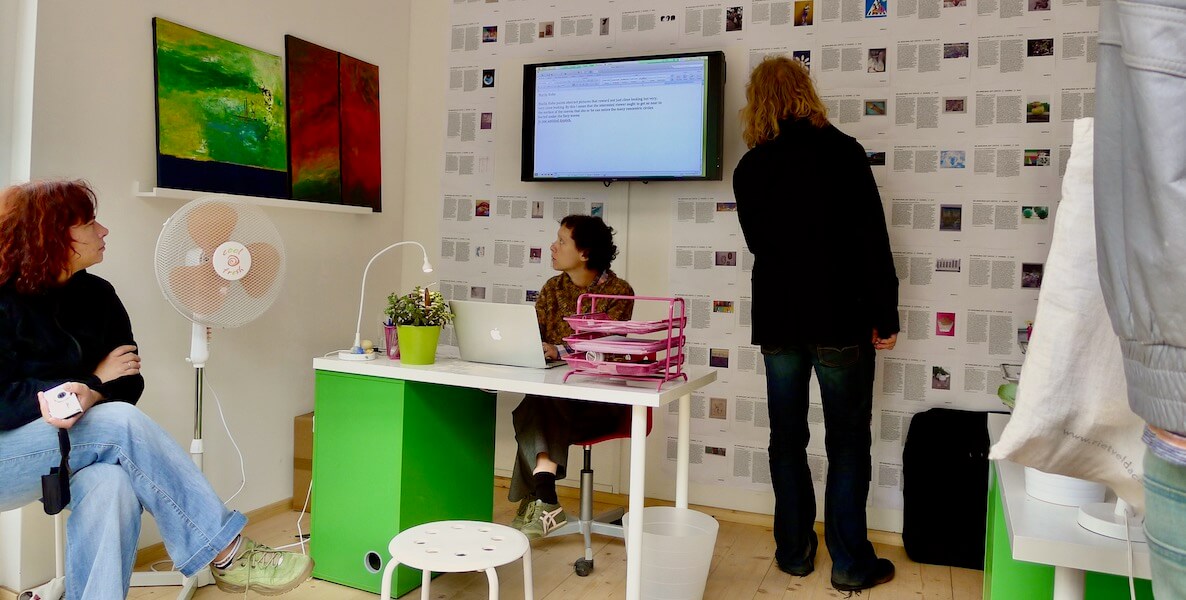Lori Waxman is an art reviewer in search of art to review. For nearly 20 years, the Chicago-based art historian, professor, and freelance art critic for the Chicago Tribune has visited cities across the U.S. (and beyond) to meet art-makers, consider their work, and type up reviews for publication. She does all this in 25 minutes a pop, in public, at no charge. On October 13-15, the “60 wrd/min critic” will be doing her thing at the Gershman Hall on Broad Street.
Waxman’s art critiquing tour began in 2005 in Brooklyn, NY, when friends suggested she offer free reviews at an art festival. The gig struck a chord, and, on the invitation of another friend, she took it to Knoxville, TN. “That’s where it became what it is now,” she says. What it is, is a lot of things.
25 minutes per artist
Here’s how it works. Artists email Waxman (critic@60wrdmin.org) to request a review appointment. Anyone who makes art or wants to represent someone who makes or made art (a family member, friend, etc.), can apply. She has critiqued the works of MFAs and hobbyists, retirees and six-year-olds.
After a couple weeks of receiving requests — the deadline for the Philly show is September 29 — Waxman randomly chooses ten artists to review per day, reaches out to them about scheduling and details (what to bring, etc.), and plans to see them during a 25-minute afternoon slot in an artist-run gallery or nonprofit arts center (in our case, U Arts’ Gershman building).
On the 60 wrd/min art critic’s review days, Waxman sets up an empty table so she can view the incoming artwork, and attaches her laptop to a monitor or projector to display her in-progress typing in real time. At noon, she begins to meet one-on-one with each artist, considers their work, writes a short review, and hands it to them — in less than a half hour. (The reviews are also published in a credible outlet, in this case, The Philadelphia Citizen.) Then, she takes a five-minute break.

How much can 25 minutes achieve?
For artists whose work has received little to no critical review, Waxman delivers “published recognition and an entry for their bibliography.” “When I’ve been able to validate someone’s practice for them, it’s important to someone in the professional world. It’s quite unique and meaningful,” she says.
While spending less than a half-hour per creator can only go so far to provide an account of an artist’s oeuvre, the critic promises feedback that’s “open-minded, useful, and supportive — but not booster-ish,” she says.
The critic’s challenge: Quickly interpret each distinct body of work — in view of a live audience that often includes the artist she’s reviewing. The setup puts the critic under as much scrutiny as the artwork. And that’s intentional.
“The audience is basically watching me think,” she says. “The less time I have, the more I’m figuring out as I write.” She refers to the on-display aspect of her role as performance art that “makes the writing process transparent. You might think it’s weird. You might think it’s interesting.”
Every kind of artist
Another real-time variable: The artists themselves, and each review’s outcome. During one stop on her tour, the parents of an incarcerated artist brought Waxman the work their son had been making in prison. Later, “They brought my review to the warden, to show him that the work was legitimate,” she says. “It got him extra privileges: more supplies, extra time to work on his art.”
In Germany, at the contemporary art exhibition dOCUMENTA (13), Waxman reviewed the work of a 20-something artist with autism. “He had a very serious artistic practice,” she says. “I was nervous: His parents were there; he was there. It was very important to them. His mother was crying at the end. I was so worried I had upset her. But she said my review legitimized for her what her son did. She realized his work was important beyond him, that it meant something beyond their family.”
Waxman’s art reviews have helped build portfolios required for non-citizen artists seeking O-1B visas. Her quick critiques have revealed insight into a loved one whose artwork surfaced after they died. They’ve validated the hopes of parents and offered direction to hundreds of people whose work had never ben reviewed.
No matter the artist, she says, “My job is to respond seriously to the work.”
Now until September 29, Waxman is accepting requests for “review appointments” for Philadelphia artists via email. Once that deadline hits, she’ll put the emails into a random generator, and choose 30 — 10 per day — to review. After that, the artists and public can view her process on October 13-15, from noon to 6pm at the University of the Arts’ Gershman Y, 401 S. Broad Street. After that, you can read the 60 wrd/min art critic’s reviews here, in The Philadelphia Citizen.
![]() MORE COVERAGE OF PHILLY ARTS AND CULTURE
MORE COVERAGE OF PHILLY ARTS AND CULTURE






